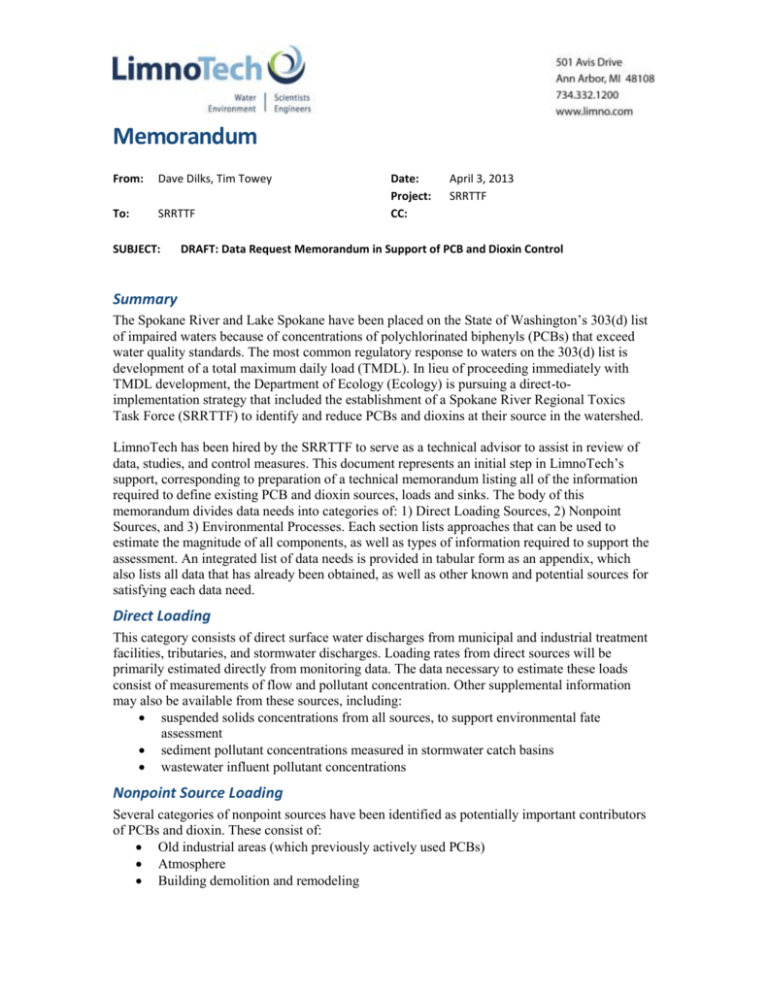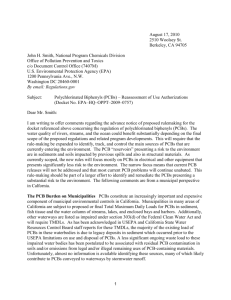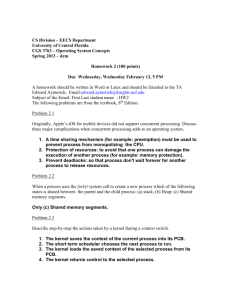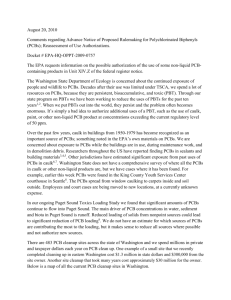Draft Data Request Memo - Spokane River Regional Toxics Task
advertisement

Memorandum From: Dave Dilks, Tim Towey To: SRRTTF SUBJECT: Date: Project: CC: April 3, 2013 SRRTTF DRAFT: Data Request Memorandum in Support of PCB and Dioxin Control Summary The Spokane River and Lake Spokane have been placed on the State of Washington’s 303(d) list of impaired waters because of concentrations of polychlorinated biphenyls (PCBs) that exceed water quality standards. The most common regulatory response to waters on the 303(d) list is development of a total maximum daily load (TMDL). In lieu of proceeding immediately with TMDL development, the Department of Ecology (Ecology) is pursuing a direct-toimplementation strategy that included the establishment of a Spokane River Regional Toxics Task Force (SRRTTF) to identify and reduce PCBs and dioxins at their source in the watershed. LimnoTech has been hired by the SRRTTF to serve as a technical advisor to assist in review of data, studies, and control measures. This document represents an initial step in LimnoTech’s support, corresponding to preparation of a technical memorandum listing all of the information required to define existing PCB and dioxin sources, loads and sinks. The body of this memorandum divides data needs into categories of: 1) Direct Loading Sources, 2) Nonpoint Sources, and 3) Environmental Processes. Each section lists approaches that can be used to estimate the magnitude of all components, as well as types of information required to support the assessment. An integrated list of data needs is provided in tabular form as an appendix, which also lists all data that has already been obtained, as well as other known and potential sources for satisfying each data need. Direct Loading This category consists of direct surface water discharges from municipal and industrial treatment facilities, tributaries, and stormwater discharges. Loading rates from direct sources will be primarily estimated directly from monitoring data. The data necessary to estimate these loads consist of measurements of flow and pollutant concentration. Other supplemental information may also be available from these sources, including: suspended solids concentrations from all sources, to support environmental fate assessment sediment pollutant concentrations measured in stormwater catch basins wastewater influent pollutant concentrations Nonpoint Source Loading Several categories of nonpoint sources have been identified as potentially important contributors of PCBs and dioxin. These consist of: Old industrial areas (which previously actively used PCBs) Atmosphere Building demolition and remodeling DRAFT: Data Request Memorandum April 3, 2013 Recycling facilities PCBs still in use Illegal disposal Old industrial areas (which previously actively used PCBs) Historical industrial activities may have caused contamination of soils with PCBs. This contaminated soil can ultimately be eroded and delivered to the Spokane River. The magnitude of loading from this source can be estimated several ways: Direct measurement of runoff volume and PCB concentration Measured soil PCB concentration multiplied by an assumed erosion rate Simple models and literature values The type of information requested necessary to conduct the above assessments include soil PCB concentration, soil characteristics, erosion studies, number and size of petroleum refineries, number and size of demolition sites, land use in 1950s). Atmosphere Atmospheric sources can be important contributor of PCBs and dioxins. It will be important to distinguish between local and non-local atmospheric sources, as future pollution control efforts will only be able to remediate local sources. The magnitude of loading from this source can be estimated several ways: Direct measurement of absorption and deposition Measurement of gas phase PCB concentrations Simple models and literature values The type of information requested necessary to conduct the above assessments include regional air quality monitoring, smokestack monitoring of major incinerators, local precipitation, number and size of incinerators, number and size of smelters, yard waste burning studies, fire-fighting reports, and vehicle registrations. Building demolition and remodeling Building demolition and remodeling can release PCBs into the environment that were previously contained in commercial products such as caulks. The magnitude of loading from this source can be estimated several ways: Direct measurement of runoff volume and PCB concentration near recent demolition sites Measured soil PCB concentration multiplied by an assumed erosion rate Simple models and literature values The type of information requested necessary to conduct the above assessments include soil PCB concentration, soil characteristics, erosion studies, number and footprints of buildings built between 1950 and 1980, and sampling of caulk on commercial buildings (if dating from 19501980). Recycling facilities Recycling facilities can reintroduce to the environment PCBs that were previously contained in commercial or industrial products. The magnitude of loading from this source can be estimated several ways: Direct measurement of runoff volume and PCB concentration near recent recycling facilities Measured soil PCB concentration multiplied by an assumed erosion rate Simple models and literature values Page | 2 DRAFT: Data Request Memorandum April 3, 2013 The type of information requested necessary to conduct the above assessments include soil PCB concentration; soil characteristics; erosion studies: and numbers and sizes of auto dismantlers, computer and electronics recyclers, transfer stations, landfills, metal recyclers, and white goods recyclers. PCBs still in use PCBs still in use are another potential source to the Spokane River. The information required to estimate the potential magnitude of this source consists of the number and size of totally enclosed applications (e.g. large scale transformers and capacitors.) Illegal disposal Illegal disposal of contaminated products can be an important source of pollutants, although the nature of the activity makes direct measurement infeasible. Police reports documenting arrests and/or reports of illegal dumping could help estimate the magnitude of this source. Manufacturing Certain manufacturing processes produce dioxins as a by-product. The information required to estimate the magnitude of this process includes number and size of relevant industrial operations (i.e. pesticide manufacturing, pulp bleaching, PVC manufacturing and petroleum refining.) Incineration Waste incineration can contribute dioxins and, to a lesser extent, PCBs to the environment. Records of the number, size, and type of incineration activities are needed to estimate the magnitude of this contribution. Environmental Processes Environmental processes control the fate of PCBs and dioxins delivered to the Spokane River, and can serve as important sinks. The key processes of concern consist of: Advection Settling to bottom sediments Resuspension from bottom sediments Deep burial Volatilization Photolysis Microbial degradation in bottom sediments Advection Advection consists of movement of pollutants in the water column via currents. The magnitude of this fate process can be estimated several ways: Direct measurement of river flows and PCB/dioxin concentrations Linked hydrologic and water quality models Simple models and literature values The type of information necessary to conduct the above assessments include measurement of river flows, water column PCBs concentrations, water column dioxin concentrations, suspended solids concentrations, particulate and dissolved organic carbon concentrations, existing hydrologic and or water quality model applications. Page | 3 DRAFT: Data Request Memorandum April 3, 2013 Settling to Bottom Sediments PCBs and dioxin both have a physical-chemical affinity to particulate matter, and can be removed from the water column when they adsorb to particles that settle out of the water column. The magnitude of this fate process can be estimated several ways: Direct measurement of suspended solids concentration combined with assumed settling rate Linked hydrologic and water quality models Sediment trap measurements The types of information necessary to conduct the above assessments include measurements of suspended solids concentrations, sediment trap measurements, and existing hydrologic and or water quality model applications. Resuspension PCBs and dioxins that had historically settled can be re-suspended into the water column when conditions exist to provide sufficient turbulence at the sediment-water interface. It can either be measured in the laboratory or estimated via the scientific literature or simple models. The information necessary to conduct the above assessments consists measurements of bed sediment porosity, sediment density, bed sediment PCB concentration, bed sediment dioxin concentration, bathymetry, and sediment organic carbon content. Deep Burial Deep burial represents net sedimentation and can essentially mitigate the effects of historical sediment contamination by covering older contaminated sediments with a layer of cleaner sediment. The magnitude of this fate process can be estimated by: Estimate as the difference between calculated settling and resuspension Infer from measurements of isotope profiles The types of information necessary to conduct the above assessments (beyond the above information necessary to calculate settling and resuspension) consist of burial velocity measurements and isotope profiles. Volatilization Volatilization represents the loss of dissolved pollutant from the water to the atmosphere. It can either be measured in the laboratory or estimated via the scientific literature or simple models. The information necessary to conduct the above assessments consist of wind speed and air temperatures. Photolysis Photolysis is the chemical degradation of a pollutant due to solar radiation. It can either be measured in the laboratory or estimated via the scientific literature or simple models. The information necessary to conduct the above assessments consists of light absorption rates, photolysis rate constants, ambient solar radiation, cloud cover). Microbial Degradation Microbial degradation represents the chemical breakdown of pollutants by microbes in the bottom sediments. Although typically a very slow process, it can be a significant loss of pollutant due to long residence times of bottom sediments. Alternate ways to estimate magnitude of process include laboratory measurements of rates, literature values, and calibration of sitespecific pollutant fate and transport models. The only type of information needed that has not been addressed previously is measurement of degradation rates in the bottom sediments. Page | 4 DRAFT: Data Request Memorandum April 3, 2013 Appendix A. Data Request Summary The information needs described above contain a significant amount of overlap. This appendix removes those redundancies and condenses the data needs into a simple tabular format. Data Category WWTP daily flow, design flow, effluent PCB, effluent dioxin, influent PCB, influent dioxin, total suspended solids Stream flow information for Spokane River and tributaries* Water column measurements of PCB and dioxin concentrations for Spokane River and tributaries Stormwater discharge flow, PCB concentration, dioxin concentration, total suspended solids Soil characteristics/ erosion studies PCB concentrations in stormwater catch basin sediments Atmospheric gas phase PCB concentrations Potential Sources Municipalities, Inland Empire Paper, Kaiser Aluminum, Ecology, IDEQ, Region X USGS Ecology, U.S. EPA Region 10, STORET, IDEQ Municipalities, Ecology Soil Survey Geographic Database (SSURGO), Municipal Planning Departments City of Spokane Universities, scientific literature Measured atmospheric deposition rates for dioxin Universities, scientific literature Number and size of smelters Toxics release inventory (TRI) Yard waste burning studies USEPA dioxin source inventory Number of vehicle registrations Department of motor vehicles Fire-fighting reports Local fire departments Soil PCB and dioxin concentration PCB and dioxin emissions from incineration activities Number and size of petroleum refineries Site specific measurements, scientific literature USEPA dioxin source inventory, scientific literature Toxics release inventory (TRI) Number and size of incinerators Toxics release inventory (TRI) Number and size of demolition sites Local government demolition permit records U.S. Census Bureau Number of commercial buildings constructed between 1950 and 1980 Land use maps for 1950 - 1980 PCB content of caulk on commercial buildings Numbers and sizes of auto dismantlers, computer and electronics recyclers, transfer stations, landfills, metal recyclers, and white goods recyclers Municipalities, U.S. Department of Agriculture, GISDATA Map Studio Scientific literature Local government listings and parcel information Page | 5 DRAFT: Data Request Memorandum Data Category Results of survey of industrial practices April 3, 2013 Large scale transformers and capacitors Potential Sources Spokane River Urban Waters Team EPA database Illegal dumping reports/arrests Local Police Departments Number and size of pesticide manufacturing, pulp bleaching, PVC manufacturing operations Dam release information Toxics release inventory (TRI), local government listings Avista Water column measurements of temperature, suspended solids, and particulate and dissolved organic carbon concentrations for Spokane River and tributaries Tributary watershed boundaries Ecology, Region 10, STORET, IDEQ USGS (2007) groundwater flow/model* Already obtained Other groundwater flow information/models USGS CE-QUAL-W2 water quality model* Already obtained Other hydrodynamic and/or water quality models Ecology, IDEQ River/lake bed sediment properties (density, porosity, organic carbon content) Site specific measurements, model calibration reports, scientific literature Ecology, U.S. EPA Region 10, STORET, IDEQ Ecology, U.S. EPA Region 10, STORET, IDEQ NOAA-NCDC River/lake bed sediment PCB and dioxin concentration Sediment trap measurements Climate data (precipitation, air temperature, solar radiation, wind speed) Sediment isotope profiles Pollutant-specific degradation rates in bed sediments National Hydrography Dataset Ecology, U.S. EPA Region 10, STORET, IDEQ Scientific literature *Indicates data sources that LimnoTech currently possesses Page | 6




